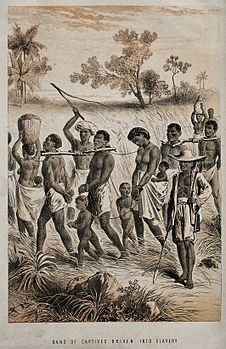In a broad view, colonialism, like globalization, is not new. Since the first hominins left Africa some 1.8 million years ago, people have been colonizing the earth. Sometimes that movement across the globe involved people encroaching on areas already inhabited by other humans. Archaeologists have been documenting the movement of peoples throughout prehistory and history, using a variety of data to reconstruct what those interactions may have looked like. Colonialism refers to the domination of one culture, society, or nation over another. In the context of modern globalization and to oversimplify, colonialism specifically refers to Western European domination over much of the world starting in the fifteenth century, but the origins of that movement is in the Asian overland-trade routes previously established. In the remainder of this article, any reference to colonialism refers specifically to Western European colonialism.

Figure \(\PageIndex{1}\) - Map of the Silk Road.
The process of colonialism left a legacy that infuses modern globalization. As Western European nations overtook control of various areas, leaders and merchants moved many indigenous peoples from their homelands to solve labor shortages faced by the colonial powers. The African slave trade is the example that comes to mind for most people, but other peoples were also enslaved, e.g., Chinese and Indian. The slave trade was possible because there was a belief that anyone not living in the manner of Western Europeans was inherently backward or lesser than white Europeans. This dehumanization, or denial of humanness, was essential to colonial practices as it provided a justification for aggressive and morally questionable practices (Haslam et al. 2007). We can still see the effects of this ideology today in various social movements such as Occupy and the green movement.

Figure \(\PageIndex{2}\) - Group of men and women being taken to a slave market.
Under European colonial rule, political and economic systems were reorganized. High-status Europeans were in charge of the colonies. By the end of the nineteenth century, colonial administrations were self-financing systems. Local indigenous leaders were bribed with titles, land, and tax breaks. This created an atmosphere of privilege that would create problems after decolonization. Local leaders then helped colonial administrators to force the local population in to a capitalist economic system. Primary commodity production, or the production of raw materials, became the enforced norm, undermining traditional crafts and mixed farming systems. Following the pattern of the forced-enclosure movement in Europe where communal lands were enclosed and used privately for the production of market-based agriculture, farmers were forced into growing cash-crops instead of growing crops for personal use. A culture of export monoculture where a country produces one or more primary commodity became established, a practice that is still at the heart of international trade today. South Africa became known for gold and diamonds, Mexico for corn, and, India for cotton, tea, peanuts, and sugar cane. As a result of this reorganization, many indigenous farmers lost their land to commercial agricultural production. Men were frequently removed from their homes to work on these industrial farms in order to meet the growing demands for goods of European urban populations. The families left behind struggled to make ends meet. Malnutrition and social unrest grew among indigenous groups.
Colonial administrators rarely acknowledged traditional female gender roles if they did not mirror the female gender role in Europe, which stated that women were the property of men, either fathers or husbands. In areas where women had property rights, they were ignored by the colonial powers. In Kenya, Kikuyu women had rights to inherit land. After European domination, men were removed to work on European-owned farms and the land assumed to be owned by those men confiscated. Women lost control of the ability to grow sufficient food for their families and lost their status, wealth, and authority.
.jpg?revision=1)
Figure \(\PageIndex{3}\) - Frontispiece from the book Saint-Domingue, ou Histoire de Ses Révolutions. ca. 1815.
The loss of self-governance and status, disruption of gender roles and family, and the loss of resources led to social unrest as large segments of indigenous populations were enslaved, killed, or died due to disease. Decolonization movements began in Haiti in 1791. The Haitian revolt was started by slaves on sugar plantations and was the only slave revolt to result in the founding of a state. Independence movements gained momentum over time, spreading to Latin America, Asia, and Africa even as late as the 1990s (South Africa). After the end of World War II, colonial subjects who had fought in the war returned with the ideologies of freedom and self-determination. As colonies gained their independence, new leaders were expected to operate on the global stage in the same manner as and with their former colonial rulers in order to be considered legitimate. Frequently, people had some power in the colonial administration due to bribery or having some relationship to the former powers gained power in the newly independent states. Many newly emerged states required economic stimulation that came in the form proscribed by the only nation that had economic growth during WWII, the United States. This model of economic development is sometimes referred to as neocolonialism; in other words, the new states were closely tied to former colonial powers economically.
We still see the lingering effects of colonial cultural imperialism, or expansion of one culture at the expense of others, in the languages, customs, and worldviews of former colonies. In Haiti, French is the national language; in Brazil, Portuguese. Spanish is spoken in most South and Central American countries, English in a wide-geographic distribution resulting from that nation’s imperialist expansion.





.jpg?revision=1)